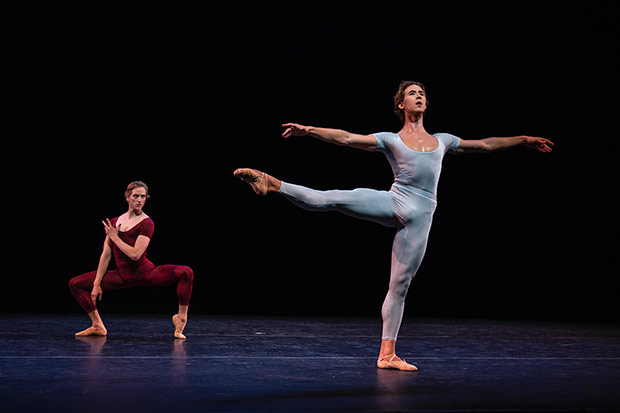
© Maria Baranova. (Click image for larger version)
Joyce Ballet Festival – Program C
Curated by Jean-Marc Puissant with dancers from The Royal Ballet, American Ballet Theatre, New York City Ballet and New York Theatre Ballet
Then and Again, Songs of a Wayfarer, Elite Syncopations (Divertissement)
★★★★✰
New York, Joyce Theater
13 August, 2019
www.joyce.org
www.roh.org.uk
If someone had told me a few decades or even a few days ago that I would be singing the praises of a work by Maurice Béjart, I’d have laughed at them. Yet here I am about to do that (to a degree) for his ballet from 1971, Songs of a Wayfarer. This, and excerpts from MacMillan’s 1974 Elite Syncopations, were a double-barreled blast of nostalgia on Program C of the Joyce Theater’s Ballet Festival, which was curated by Jean-Marc Puissant, the veteran costume and set designer who has worked extensively with The Royal Ballet. Gemma Bond’s Then and Again, which premiered at The Joyce’s Festival two years ago, rounded out this perplexingly random program.
Back in the Seventies, Béjart was popular in Europe, and the choreographer that New York critics loved to hate. His works weren’t just awful, but spectacularly so. Pretentious and bombastic, graceless and unmusical, they were a perfect storm of bad taste. However, I might admit that his over-the-top Bolero is a classic guilty pleasure. I regret missing Suzanne Farrell and Plisetskaya as the table dancer; I made do with the incomparable Jorge Donn. Sometimes Béjart’s audacity resulted in brilliant, if unintentional, kitsch. I’ll never forget the Spectre de la Rose he made for Judith Jamison. As the sleeping girl, she awoke and dominated an unfortunate, vampiric Spectre, then leapt out the window herself. More often, the wrongness just hurt. After a performance of excerpts from his Romeo and Juliet, a sharp-tongued colleague epitaphed all things Béjart with “you can feel yourself getting stupider as you watch it.”
I feared more of the same from Songs of a Wayfarer. I’d never seen it, but knowing that it had been made for Rudolph Nureyev and Paulo Bortoluzzi, I imagined it would be narcissistic, ego-stroking trashy hero-worship, with a dash of is-it-really-homoerotica (a favorite theme of Béjart’s). I couldn’t have been more wrong. Wayfarer proved to be carefully constructed and relatively free of Béjart’s excess. Moreover, and not surprisingly considering its original cast, Wayfarer was a vehicle for two stellar performances, from New York City Ballet’s Joseph Gordon, and American Ballet Theatre’s David Hallberg. Set to a glorious recording by Dietrich Fischer-Dieskau of four of Mahler’s Wayfarer songs, the ballet is a fairly straightforward depiction of a young man’s (Gordon) journey through adulthood, beginning joyfully, but always in the presence of an increasingly intrusive fate figure (Hallberg), who eventually leads the man away into upstage darkness.
Béjart uses conventional modern-dance and ballet methods to tell this straightforward narrative, and with great skill, although there are already signs of his future choreographic hubris. Gordon, in a pale blue unitard, begins the ballet with steps which become a leitmotif for his life’s journey: lift one leg forward, then a slow battement to the side, coming down into a grand plie in second, one heel raised, roll the head to the left and swing the right arm up so the hand rests just below the chin. It looked far better on Gordon than my clunky words might imply. Viewed in isolation, this phrase has no intrinsic meaning; in fact, it’s opaque. (Béjart would become increasingly fond of shilling such odd imagery as great profundities; it was wearying.) But, in the ballet’s context, each repetition becomes more redolent of the wayfarer and his journey. By the time, late in the ballet, when Hallberg’s destiny figure yanked Gordon away by the hand before he could finish settling into that pose in second, it was a violation of the wayfarer’s existence as much as a dance phrase interrupted. So resonant were the dancers’ performances that I didn’t just see Gordon’s shock and pain, but felt it like a punch to the gut.
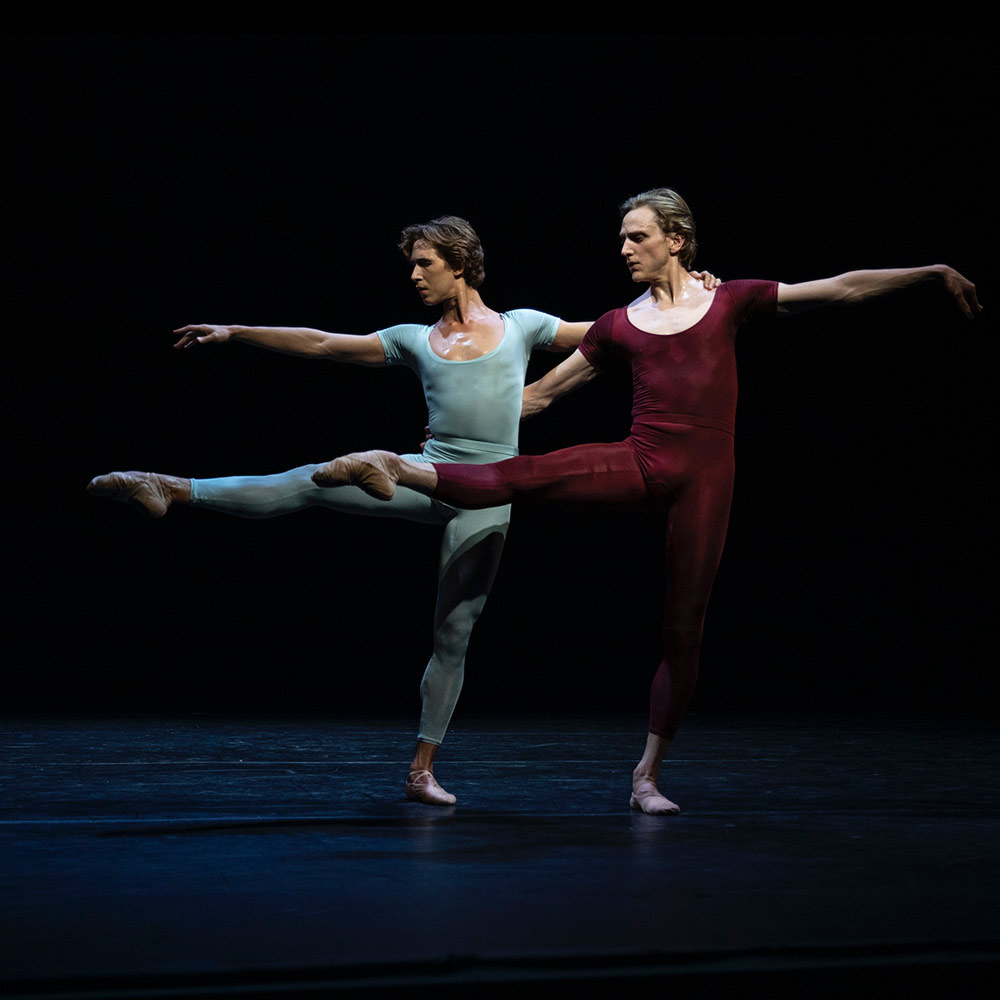
© Maria Baranova. (Click image for larger version)
Wayfarer is set to four of Mahler’s exquisite songs. In the first, Gordon did That Phrase, and looked at the world out beyond and above the audience’s heads with such fresh-faced joy it could have been the beginning of Oklahoma. Béjart’s steps are not particularly musical, but, through shading and nuance, Gordon evoked a roiling sea of emotions as dynamic as Fischer-Dieskau’s Romantic baritone. It was thrilling. Hallberg, in dark mauve, remained motionless upstage, his back to the audience, then stalked the oblivious Gordon, pacing across the stage and back, and glared at him from beneath hooded brows, a bald eagle eyeing a field mouse.
They soon met, and were the happiest of bros, dancing before each other, in turns. Hallberg took an elegant knee in a downstage corner, cowbells pealed, and Gordon exulted. For an instant, he soared in a beautiful attitude sauté, ecstatic face turned to Hallberg, and you could almost him surrounded by an alpine vista, a future of endless possibility before him. It should go without saying that it is all downhill for the poor Wayfarer after this.
By degrees, like the world’s most toxic boyfriend, Hallberg closed in on Gordon, insinuating himself into his world, then blocking his way and forcing his movements, first subtly and then with violence, even interrupting, as described, the motif of Gordon’s existence. I remember at one point Gordon stepped into a gorgeous outside pirouette, finishing seamlessly into an ever shrinking turn until he’s on his knees facing Hallberg, a luxuriant moment amidst adversity – Béjart could make his male dancers look good, when he felt like it.
They shared a gorgeous pirouette moment, each finishing in a deep backbend in fourth. With a hand on Gordon’s shoulder from behind, Hallberg squired him like a puppet master, and soon Hallberg lay supine, trapping Gordon’s feet between his knees. Rooted to the spot, Gordon struggled. In an island of dim light on a darkened stage, Gordon took Hallberg’s proffered hand, and was led upstage, turning and reaching desperately towards the audience before vanishing into blackness. It’s melodrama verging on cliché, but it was well-earned, done with drop-dead sincerity, and I was sold long before my last glimpse of Gordon’s terrified face.
From Gordon, it was the work of an artist coming into greatness, while Hallberg may not have been entirely in his finest condition. The audience roared its approval in tribute as much to Maina Gielgud’s staging as the dancers, and a choreographer friend of mine immediately spent a painful amount of money to return the next night. I might’ve, too, if I hadn’t been broke. So maybe Béjart batted .250 instead of .100.
I was looking forward to the closing divertissement of excerpts from Sir Kenneth MacMillan’s ragtime fantasia, Elite Syncopations, even though, when I first saw it performed by the Royal Ballet at the Met in 1976, I didn’t much like it. Despite its bright trappings, it was slick, unimaginative, and, not unlike Wayfarer, dependent on strong performances to bring it to life, or, in this case, animation. Only a few years earlier, the United States had seen a revival of interest in ragtime, particularly the works of Scott Joplin, sparked by the release, starting in 1970, of Joshua Rifkin’s sensitive and influential recordings of that composer’s piano rags. Ragtime, we learned, was art, and should be treated as such. In Elite Syncopations, MacMillan hadn’t gotten the memo. The ballet’s rinky-tink orchestrations (played by an onstage pianist and band) were, to my refined teenage sensibilities, disrespectful, and a cliché — as quaint as that era’s too-fast, herky-jerky silent movies, and suitable background for a Saturday matinee melodrama. Ian Spurling celebrated, cartoonish costumes just reinforced this presentation of ragtime as shallow, campy fun.
But, perhaps more to MacMillan’s point, shallow, campy, and raunchy fun. Whatever ragtime had evolved into by the early 1900s, when most of Elite Syncopations rags were written (some by James Scott and other worthy colleagues of Joplin’s), it began, perhaps apocryphally, in brothels. Most of the ballet’s numbers appear to be set in one, or perhaps a disreputable dance hall. There’s an incongruous Depression style dance competition to muddy the thematic waters; the ballet’s fuzzy mise en scène is not among its strengths. Spurling’s skintight unitards were hand painted and ornamented to suggest the couture of an acid-dream melange of the Gay Nineties and Roaring Twenties. Garish and over-the-top. While the men were painted into vests, jackets, and striped trousers, the women’s costumes were more fanciful and revealing. I can’t recall if they were based on the milliskin unitards so popular in the Seventies, which left nothing to the imagination, but they might well have been. The arrows pointing to every button on a one woman’s outfit were cheeky, but also screamed “unsnap here!” Another costume’s conspicuous star drew your eye much too far below the ballerina’s navel for discretion. Spurling’s designs and palette of colors from a child’s box of crayons said that this vulgarity was all in fun; MacMillan’s choreography, being MacMillan’s, said, “well, actually.” There was hardly a moment between the sexes which didn’t speak of a transaction. The dancers in the Seventies made sport of this, the women’s ensemble enthusiastically presented their legs to the surrounding male gaze as like the daily special at a meat market. Or when smarmy Derek Rencher concluded his adagio with worldly, star-crotched Natalia Makarova by carrying her offstage like a trophy held high above his head in an upside-down split, there was little doubt where they were off to, and why.
Many years ago, I admired that same sharp-tongued colleague for calling out a ballet as both louche and twee. Elite Syncopations is both, or tries to be. They don’t play nice together. It gave me the creeps in the Seventies, and it gives me the creeps now, and it feels as wrong as it would be if a couple of your favorite childhood cartoon characters started hitting on each other. (I’m sure there’s fanfic where Shaggy and Velma hook up, but I can’t find it.) I don’t think the ballet’s creators considered this dichotomy as anything other than charming, if they considered it at all, and it’s complacent short-sightedness like this which makes Elite Syncopations a far weaker ballet than it should, or needs to be. I’m sure there’s a killer ragtime cartoon whorehouse ballet out there somewhere waiting to be made, but this ain’t it.
Speaking of complacency, despite some entertaining passages, MacMillan’s choreography is as facile as the orchestrations and decor, as if dance and dancers were cutouts from Spurling’s day-go coloring book. There’s lots of cutesy leaning from side to side, or front to back, as if the dancers had been pushed about by the fingers of an unimaginative child. When the entire ensemble dances, they tend to pair up and dance in unison; it’s not that interesting. The women slide into big tendus in demi-plie, the better to present their backsides for our delectation. They preen and primp for the men, and seem always to have their “game face” on. Solos like “Calliope Rag” and “Stop-Time Rag” are mostly about the ballerina as an aloof object of desire. The men, well, are manly — running about showing off their biceps, as if they’d stepped out of a poster of a circus strong man. Strutting about in self-centered smugness, not quite leering at the women, but almost equally affectless, except for some best-forgotten comic bits (like the almost unbearable short guy/tall lady combo). I think of the evil fun a choreographer like Paul Taylor might’ve made of this setting, and how oddly content MacMillan seems with cliché and caricature. There’s more imagination and authenticity in sixty seconds of the balcony pas de deux from MacMillan’s Romeo and Juliet than there is this entire ballet. Sixty seconds of the Pillow Dance, even.

© Maria Baranova. (Click image for larger version)
Anyway, back to Program C. I couldn’t see any thematic connection between Elite Syncopations and the rest of the program, and, despite all my above reservations, I was curious how even excerpts would look after so many years, by such fine dancers. The innuendo is still in the steps, but muted. The star adorning Sarah Lamb’s white unitard now rests a respectable inch or two below her navel. Perhaps it’s the cynicism of my old age, but, to varying degrees, Calvin Richardson, Marcelino Sambé, and Joseph Sissons, were so emphatically clean-cut I wondered what they might be hiding, as their forays into MacMillan’s sexier bits hinted at indifferently masked depths of sensuality. ABT’s Cassandra Trenary made a slow motion strip-tease out of “Calliope Rag,” or what might have been one had she not already been stripped down to the lycra and paint of Spurling’s unitard, the one with the prominent buttons and arrows. Or perhaps her jutting hips, sinuous backside and frequent presentations of her slowly rocking derriere were a dispassionate mating display. Trenary insinuated what her buttons and arrows invited, and, while I enjoyed the iron control of her wantonness, I also thought, “Really, Sir Kenneth?” What was it with that man and women?
Marcelino Sambé, I’m sad to say, overpowered the intricacies of “Friday Night.” The solo’s deceptively hard, with precise low jumps and rapid changes of direction and some perversely tricky high leaps. It’s precious, but just the thing a dandyish fellow in candystriped tights and pretty boutonniere might toss off, and with condescending punctilio. Sambé made too many steps into bravura, and the fussy solo became fuzzy. It’s not an occasion for suborbital flight, as thrilling a leaper as he might be. He was like the proverbial amp which goes to eleven, but with a toggle switch instead of a knob. He held back so little he even seemed to flag a bit towards the end. This mess was so out of character for the charismatic and savvy dancer I’d come to expect that I wondered if I’d somehow looked at it wrong.
Sarah Lamb, brilliant as the sun off a glacier in her white bodysuit (with the no-longer-slutty star), seemed hardly to have broken a sweat throughout the ballet, and certainly not in her climactic adagio with Calvin Richardson, to Joplin’s gorgeous “Bethena: a Concert Waltz.” Her purity and line were flawless, and I almost wanted to thank Richardson for lifting her into so many gorgeous, airborne arabesques. This pair of happy narcissists didn’t flirt; they were too busy admiring themselves; shiny objects, like a certain ballet I might mention. Lamb’s hard, enameled affect was its own kind of creepy. Offstage, she probably wasn’t about to eat Richardson alive, but I did hope he’d brought a snack with which to distract her while he fled, just in case. In control and calmly affectless, she exuded little overt self-satisfaction, except, sometimes, a sang so froid it burned and the unnerving hint of a smile, like Even Rachel Wood reaching for her revolver. (Note: In the TV series Westworld, Wood plays a scary sexy robot who becomes sentient and murders humans. A lot of humans.)
I wish I could love Elite Syncopations. It’s certainly bright and perky. But the arrangements are happily oblivious to the music’s soul, and the costumes are literally skin deep. MacMillan’s dances, too, are all surface, and lazy work, and either creepy, cynical, or both. It’s as if he cared far more how Elite Syncopations looked than what it actually did. The cruel truth is this ballet could’ve been made by Peter Martins. Or Béjart.
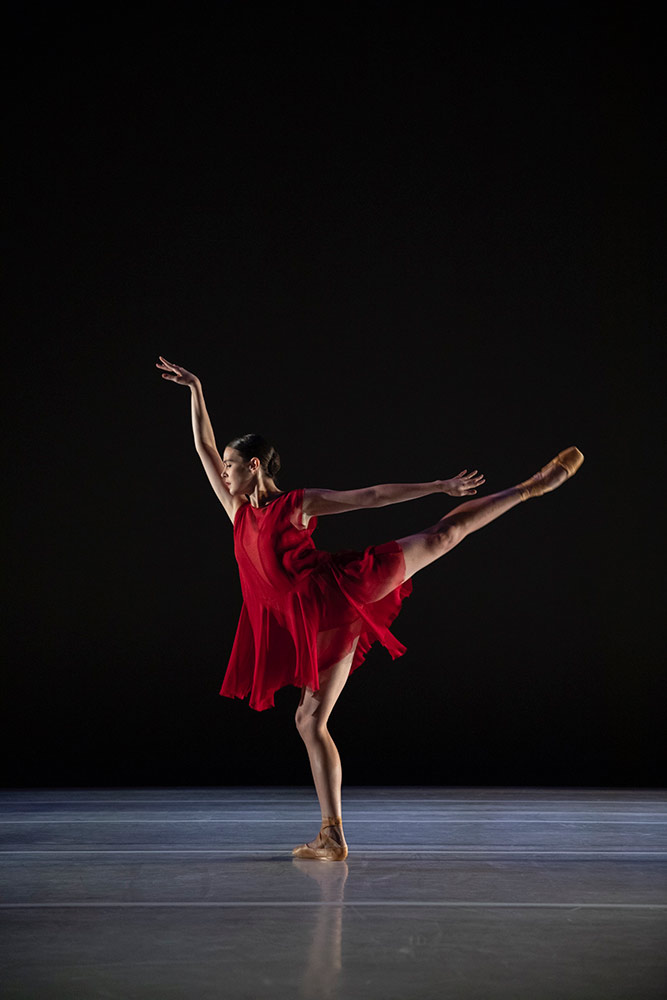
© Maria Baranova. (Click image for larger version)
The program actually began with Gemma Bond’s Then and Again, which premiered at the Joyce’s Ballet Festival two years ago. Much as with her Seventy Two Hours, from Program B, I find I have little to say about it. It’s set to Alfredo Piatti’s “12 Caprices for Solo Cello,” and it’s pretty and evanescent. Bond again shows her command of the choreographer’s toolkit. She musters about her six women and two men with light-handed authority. She deftly combined and disassembled her group women, like a darting shoal of fish. Most of the women were dark haired, of a similar size, and looked nearly identical in their red dresses, although ABT’s tall Thomas Forster nicely complemented New York Theatre Ballet’s Erez Milatin. Bond had a striking way with her women’s arms and there was a slightly incongruous section where they were accompanied by their size-shifting shadows, cast upstage by a pair of footlights, and a pair of well-constructed adagios. Smart and tasteful, Then and Again had much going for it, except a reason to watch it.
Depending on one’s point of view, Puissant’s slightly offbeat programing was either incongruous or a study in contrasts, or would have been if Then and Again had stood up to its striking companions. Wayfarer was a surprise hit and Elite Syncopations the return of an of an old frenemy. I suppose Then and Again was a lace doily. Starwise, Wayfarer bumps this program from two stars to four.













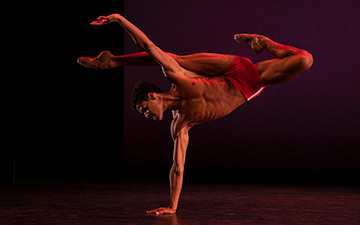
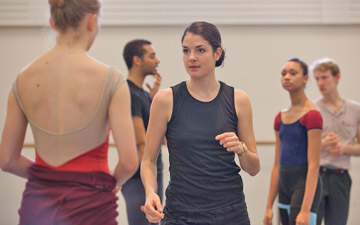
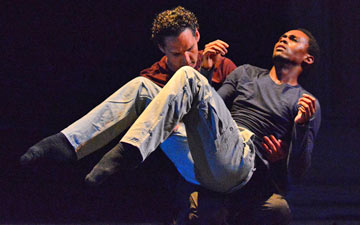
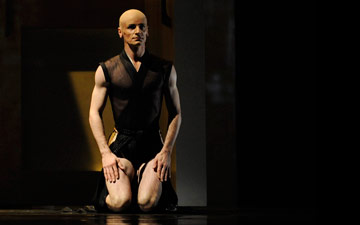
The writing of this is transcendent. The mesh of moments here observed pulsate in a thrilling fashion so rarely seen other wheres. Suddenly one can feel the critical sun escape from behind the (even hereabouts) reviewer’s shade. This will – as it should – live as history. At the risk of being ungratefully churlish I chime: More please. MUCH more.
Bruce, I am speechless at the depth and breadth of your many kind words. I am glad you enjoyed the review. Thank you from the bottom of my heart. –Eric
Eric, you’ve begun to back with a happy vengeance with your all-seeing eye and appraisal. What relish to read. I’ve never seen Songs of a Wayfarer, and you helped make me see why it’s been so commented on in Europe.
As for Elite Sycopations, SF Ballet mounted it at least one season. When Muriel Maffre danced her final performance with the company, she was partnered by James Sofranko – I think it’s the same one Sarah Lamb essayed. But the SFB contrast ran to the relative heights of the two and was played as a spoof. I remember the work as depicting some cheesy London border life diversion.
It’s great to read you once more.